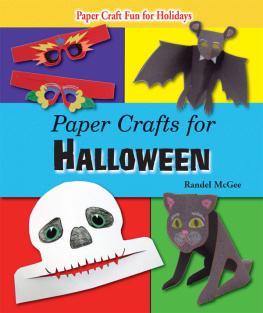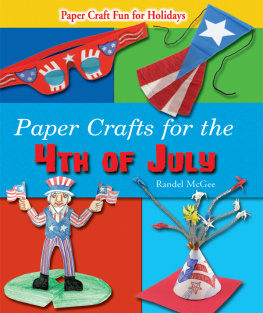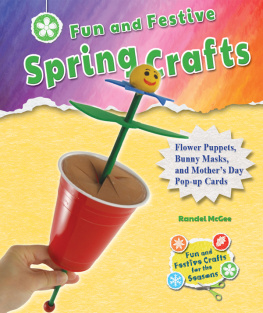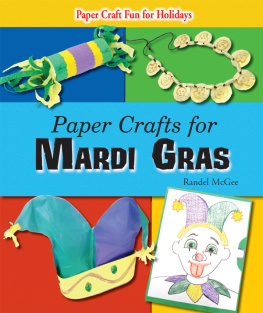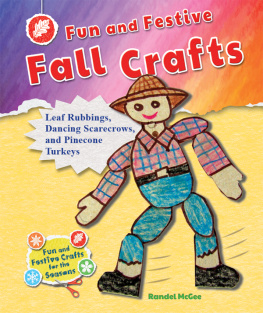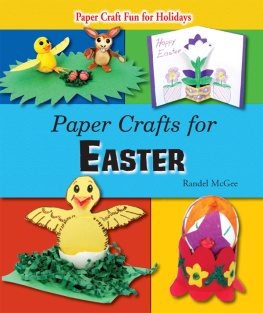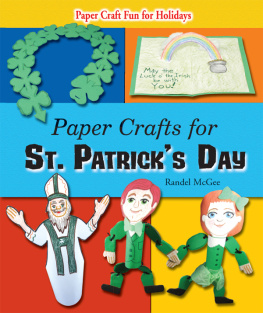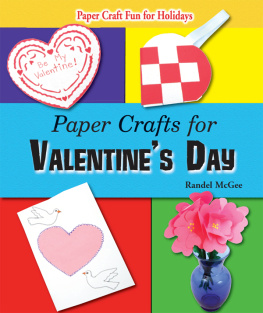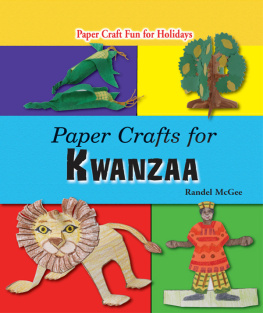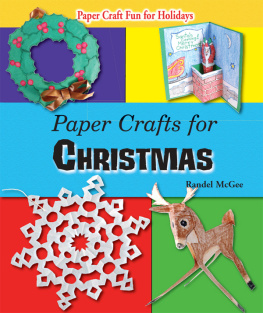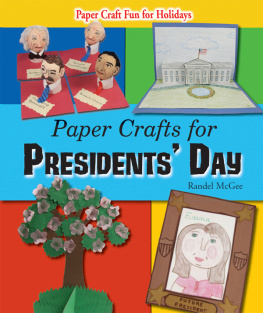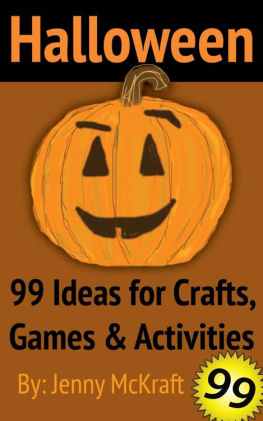GHOSTS! WITCHES! BATS!
Do you want to make your own haunted house? Haunted houses are a fun and scary part of Halloween. Follow storyteller Randel McGee as he explores Halloween in Paper Crafts for Halloween. Learn to make a flying bat, sitting black cat, goofy goggles, and even a haunted house!
Halloween is a favorite holiday for young and old alike. McGee has combined a brief history of the origins of the holiday with some great crafts. Join your children in making these fun paper crafts while you celebrate Halloween.
Duncan R. Jamieson, Ph.D., Professor of History, Ashland University
ABOUT THE AUTHOR
Randel McGee is a storyteller, puppeteer, ventriloquist, and paper-cutting artist. He performs all over the world, sharing his paper-cutting stories with children and adults. This is his first series with Enslow Publishers, Inc.

What a night! An evening of mystery and mischief, masks and make-believe, fun and fantasies! A holiday that is centuries old, yet always seems to keep up with the times! What night is this? Why, All Hallows Even or Halloween!
This holiday had its beginning in ancient times. The Celts were people that lived in northern Europe, England, Scotland, and Ireland thousands of years ago. They celebrated the end of the summer, the end of their year, and the harvest season on a day that we know as October 31. They called the day Samhain (SOW-in). It was thought that on this night the spirits of the dead could return to earth. These spirits could do mischief and harm to the living, so people disguised themselves as spirits or scary creatures to fool them.
Druids were the spiritual leaders of the Celts and were thought to have special powers to understand the forces of nature. On this night the druids would light a big bonfire. People from miles around would put out their home fires and then travel to the bonfire to collect hot embers. The embers were used to relight their fires as a sign of a new beginning to the year.
Roman armies conquered the Celts by A.D. 43. The Romans had their own holidays for honoring the dead and celebrating the harvest. The Celts accepted many of the Roman celebrations and mixed them with their own traditions. Christianity came to the Celts and brought with it many of its holidays.
During the 800s, the Catholic pope, Boniface IV, declared November 1 as All Hallows Mass. Hallow meant a saint or holy person, so this was a day to honor all the saints. The evening before this day became known as All Hallows Even, and over the years, was shortened to Halloween.
November 2 was All Souls Day, the day to honor all loved ones who had died. On this day, English children would go a souling, visiting neighbors for little soul cakes, treats made to reward the children for saying prayers for the dead. This may be where the tradition of trick-or-treating started. November 2 is still celebrated in many Spanish-speaking countries as the Day of the Dead, or Da de los Muertos. These two days and the night before them were known as Hallowmas.

Image Credit: Shutterstock
Halloween was a popular holiday in old Ireland. It is from the Irish that we get the traditions of wearing costumes and carving jack-o-lanterns for Halloween. Thousands of Irish came to the United States during the 1800s. They brought with them their Halloween traditions. Halloween became a popular holiday for Americans. It is a day of fun, dressing up in costumes, and community sharing.
The scarecrow is used to scare away unwanted pests from gardens and fields. It is a protector of the fruits and vegetables that are part of the harvest. The scarecrow makes a great symbol of Halloween because he scares away pesky animals, has a funny face, and is usually dressed in old clothes. This scarecrow can also jump and dance, which is sure to scare away any pest that comes his way.
- tracing paper
- pencil
- white glue
- light cardboard
- crayons or markers
- scissors
- hole punch
- ruler
- string
- paper fasteners
- bead (plastic or wood), about the size of a large pea
1. Use tracing paper to transfer the pattern of the scarecrow and all the parts from .

2. Glue the tracing paper with the pattern onto light cardboard (See A).
3. Decorate the scarecrow and the different parts as you wish with markers or crayons.
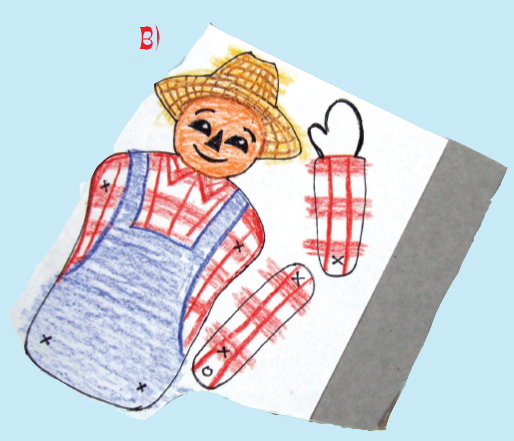
4. Cut the pattern out of the light cardboard (See B).

5. Use a hole punch to make holes where the Os and Xs are marked on the pattern (See C).
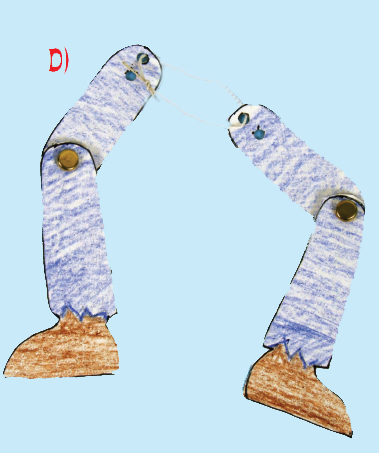
6. Tie a 7-inch-long piece of string to the tops of the arms and legs (See D), through each hole that was marked with an O. Tie a 10- to 12-inch-long string through the hole in the top of the head.

7. Put a paper fastener through each hole that was marked with an X. Fasten the arms and legs together, and then fasten them to the body (See E).
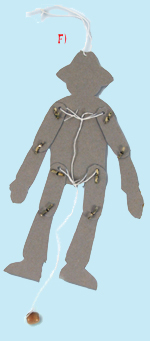
8. Fasten a 14-inch-long string to the short strings connecting the arms and legs. Tie the bead on the end of the string (See F).

9. Hang on to the string at the top of the scarecrow and gently tug on the bead to make the scarecrows arms and legs swing and jump.
The bat has long been a symbol of Halloweenbut why? The ancient Celts built huge bonfires on the night that they thought the dead returned to earth. These bright fires probably attracted thousands of moths, mosquitoes, and flies, and these insects are bats favorite foods. People would see the bats swooping above the fire. They thought the bats were the pets of witches and evil spirits. We now know that bats are harmless, helpful animals, and not evil. Here is a bat to swoop over your Halloween party.
- tracing paper
- pencil
- brown or black construction paper
- scissors
- crayons or markers
- colored chalk (optional)
- string
- ruler
- clear tape

1. Use tracing paper to transfer the pattern from to dark construction paper.

